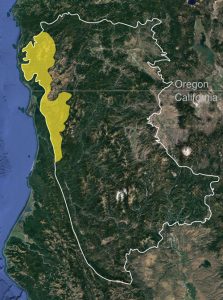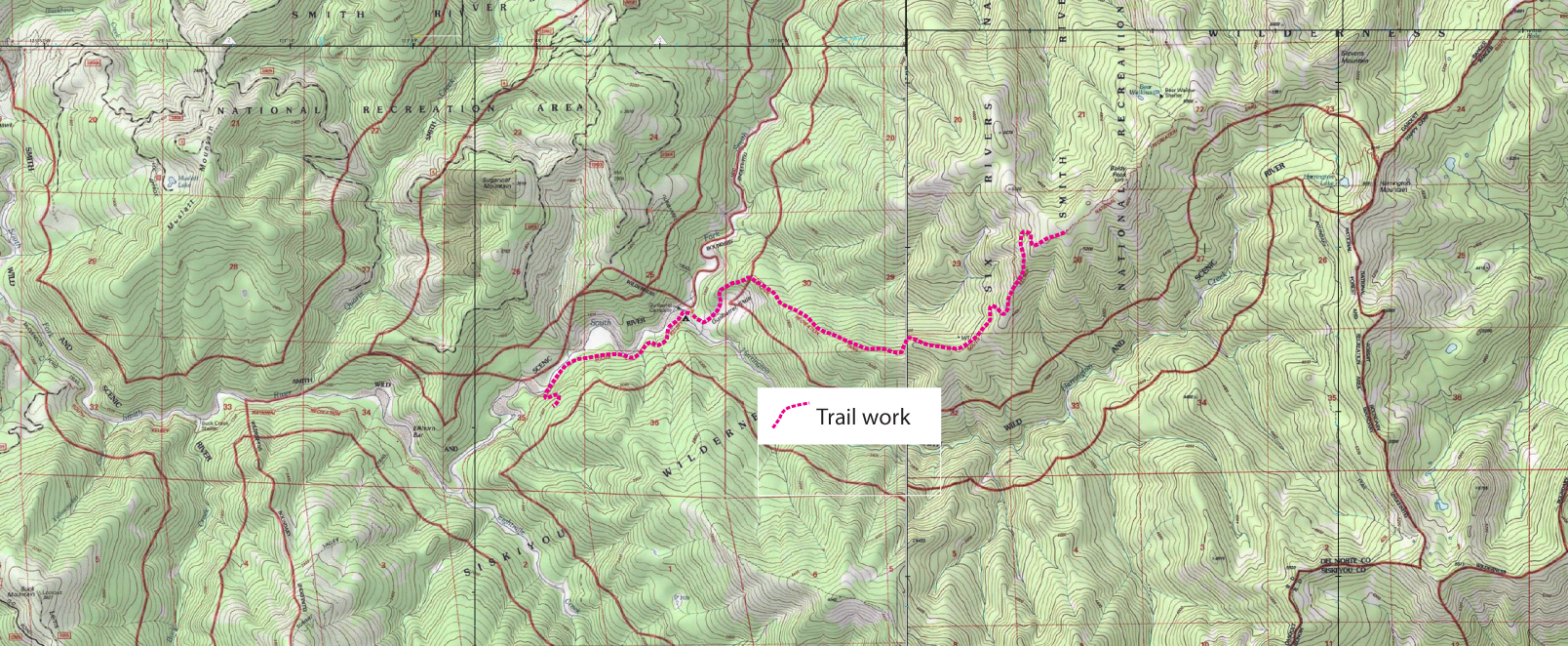The Klamath Mountains

The coastal lowland forests receive the most annual rainfall of anywhere else in the Klamath Mountains. From the north in Oregon the Coquille, Rogue, and Illinois rivers drain southwest Oregon and the Smith River country is California’s only temperate rainforest. The rich soils, temperate year-round growing season, and high rainfall (often over 100 inches) nurture these impressive forests.
Klamath coastal lowland forests are typified by dense, closed canopies on well-developed soils (sometimes serpentines). The dominant tree species have high colonizing abilities, long life, and a wide ecological tolerances to environmental conditions, including dry summers with occasional persistent fog. These forest thrive below the snow belt on the extreme western slopes of the Siskiyou Mountains. Species like Douglas-fir (Pseudotsuga menziesii) and Port Orford-cedar (Chamaecyparis lawsoniana) secure the highest place in the canopy, often approaching 300’. A second canopy forms one hundred feet below and includes species like tanoak (Notholithocarpus densiflorus) and madrone (Arbutus menziesii) where they share an understory with coastal specialists like salal (Gaultheria shallon) and evergreen huckleberry (Vaccinium ovatum). With the high volumes of rain that falls each winter, banks of coastal rivers and streams are frequently disturbed and then repeatedly pioneered by red alder (Alnus rubra).
South Kelsey Trail
This is my favorite hike in a coastal lowland forest of the Klamath Mountains. In addition to being a segment of the historic Kelsey Trail, it is also the final stretch of the Bigfoot Trail in the Klamath. I recently spent five days working with a crew of dedicated volunteers clearing this trail. While noted on the Six Rivers National Forest as a National Recreation Trail, the steep terrain and high rainfall make this a difficult segment to maintain and it has see years without any work. It is our goal to adopt this section of trail and spend time on it each year to get it back to enjoyable hiking conditions. The following are a few botanical highlights from the route.

Other Observations
- eBird List
- iNaturalist Observations (June 15-20)
Thank you for your work, on the trail and in your writing. People need trails like this, and the information on the flora that lives along it, to appreciate and protect the natural beauty that abounds here.
Thanks Michael – I like scheduling trail work when the flowers are blooming!
Hallo from Scotland!
Wish I were In Klamath temperate rain forest!
Making do with Equisetum fluviatile in the drains on the margins of a felled Sitka spruce plantation on the deep acid peat of Scottish moorland at about 1000 ft. Equisetum sylvaticum in the shadier places and E. arvense on the dykes (artificial banks).
The only native conifer here is Taxus baccata, which grows well amongst the plantations and on estate parkland (land around big houses planted with unusual trees for amenity and interest.
In the grassy meadows on ex-farmland, Platanthera chlorantha is in flower, and Dactylorhiza purpurella is in bud. A population of Epipactis helleborine struggles to keep going on the edge of a town path (sidewalk).
I am waiting for the Wild raspberry (Rubus idaeus) fruits to ripen as they make excellent jam (we have yellow and red fruited types here).
I am off soon to meet family in southern England, where the chalk flora is wonderfully varied and ‘pure’ yew woodlands are common.
Well done for clearing trails so others can use them!
Good botanising!
Ruth
Michael,
I recently hiked the Bigfoot Trail from Crescent City to the junction with Pacific Crest Trail with my friend Vern Higham, then the PCT down to Dunsmuir. It was a great hike and hopefully a prelude to summer hikes in the Pacific Northwest for years to come. Memorable moments included my discovery of red huckleberries on the trail ( to me, red blueberries! wow!!)
Thanks for sharing Jamie! I’d love to hear more from you and Vern. Hopefully you enjoyed the newly cleared Kelsey Trail (at least partly).
I’m hoping you can help me identify (conifer?) seeds that have sporadically been falling for the last month. I live in a coastal lowland forest dominated by redwood with a scattering of Doug fir, Western hemlock, Sitka spruce, Port Orford cedar and grand fir, as well as neighborhood ornamentals.
The light tan colored seeds are almond shaped, 2mm wide by 4mm long, are in the middle of a translucent tan, 6mm bi-lobed wing and are abundant.
Bill- Based on the fact you say they are abundant, and I have them falling in my yard currently, my best guess is Douglas-fir. Sounds like you have some amazing diversity in your yard! Where do you live?
Hi Michael- Doug fir was my first guess too, but D-f seeds are far larger and have a solitary wing. I worked my way down my list, in a process of elimination that included some vocal complaints about the inadequacy of the internet to key out conifer seeds. At this point, my better half pulled a well thumbed copy of Rudi Becking’s Pocket Flora of the Redwood Forest and in hardly any time found a clear, hand drawn illustration with a strong likeness to my mystery seeds. We’re proclaiming the seeds to be Port Orford cedar.
I neglected to include the planted Western red cedar and beach pine in my list of conifers. We live in the city limits of Arcata.